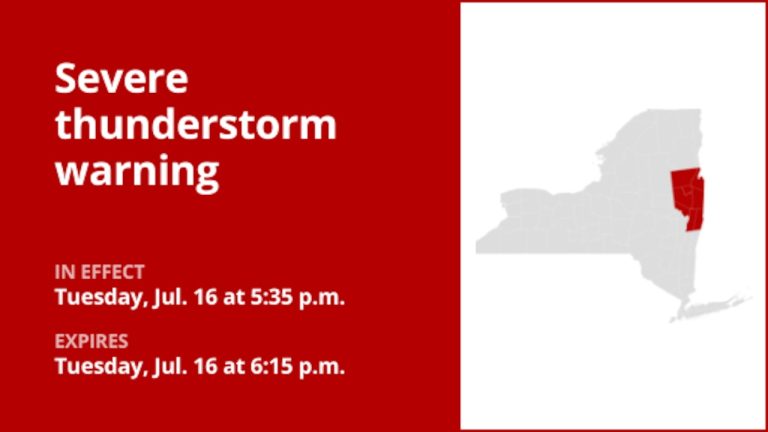The National Weather Service issued an updated severe thunderstorm warning for Rensselaer, Saratoga, Warren and Washington counties at 5:35 p.m. Tuesday, which is in effect until 6:15 p.m.
Residents should prepare for wind gusts of up to 80 miles per hour.
“At 5:34 p.m., severe thunderstorms developed along a line from 7 miles east of Chestertown and 6 miles northwest of Salem to near Mechanicville, with winds of 50 mph,” the weather service said. Speed is moving east. “Flying debris will be dangerous for those without shelter. Mobile homes will be severely damaged. Considerable damage to roofs, windows and vehicles is expected. Extensive tree damage is possible. Damage and power outage.”
Locations affected by the warning include Bennington, Saratoga Springs, Hudson Falls, Mechanicville, Hoosick Falls, Whitehall, Arlington, Salem, Manchester, Stratton, Bowles Donspar, Shaftesbury, Fort Edward, Granville, Hartford, Dorset, Cambridge, Greenwich, Round Lake and Eagle Point campgrounds.
The weather service commented: “Be alert for possible tornadoes! Tornadoes can develop quickly after severe thunderstorms. If you see a tornado, immediately go into a basement or a small central room with a sturdy structure. For your protection, move inside Room These storms are producing heavy rainfall on the lowest floors of buildings and may cause flooding. Please do not drive through flooded roadways.
Stay safe when lightning approaches: Expert advice
Each year, there are approximately 25 million lightning strikes in the United States, most of which occur during the summer. Unfortunately, lightning kills about 20 people every year, according to weather department reports. The threat of lightning becomes more apparent as the thunderstorm gets closer, peaks when the thunderstorm reaches directly overhead, and gradually diminishes as the thunderstorm moves away.
To ensure your safety during a thunderstorm, consider the following tips:
Lightning Safety Plan:
- When venturing outdoors, it's crucial to have a clear plan for seeking shelter in the event of lightning.
- Stay alert by monitoring the sky for ominous signs and listening for thunder. If you hear thunder, it's a sure sign that lightning is nearby.
- Find safe shelter, preferably indoors.
Indoor safety measures:
- Once inside, avoid corded phones, electrical equipment, plumbing fixtures, and stay away from doors and windows.
- Lightning can travel along conductive paths, and these precautions can reduce the risk of power surges.
Wait until everything clears up:
- After the last lightning strike or strike, wait at least 30 minutes before resuming outdoor activities.
- It's important to remember that lightning can strike even if the storm seems to have passed, so be careful.
When indoor shelter is not available:
If you find yourself outdoors during a thunderstorm and unable to access an indoor shelter, take the following steps to maximize your safety:
- Avoid open fields, hilltops or ridges as they put you at greater risk of lightning strikes.
- Avoid tall, isolated trees and other protruding objects. In forested areas, stay closer to lower trees.
- If you are with a group of people, make sure people are spread out to prevent lightning currents from spreading from person to person.
- Camping in the open during thunderstorms is strongly discouraged. If you have no other options, camp in a valley, canyon, or other low-lying area. Keep in mind that tents do not provide lightning protection.
- Keep away from water, wet objects or metal objects. Although water and metals do not attract lightning, they conduct electricity effectively and can pose significant risks.
In summary, preparation and vigilance are your best allies when faced with lightning threats. By following these guidelines, you can significantly reduce the likelihood of a lightning-related incident and prioritize your safety.
Dealing with Heavy Rain: Basic Safety Measures for Wet Roads
Heavy rainfall, if prolonged or with excessive runoff, can cause flooding. Excessive runoff can be caused by ground saturation and/or rainfall intensity. Follow these weather service recommendations to stay safe during heavy rain:
Beware of swollen ducts:
During heavy rain, do not park or walk near culverts or drainage ditches, where strong currents can pose serious dangers.
Maintain a safe driving distance:
Use the two-second rule to maintain a safe distance from the vehicle in front of you, and allow an extra two seconds in heavy rain.
Slow down and drive with caution:
On wet roads, reducing your speed is crucial. Gradually release the accelerator pedal and avoid sudden braking to prevent skidding.
Choose your lane wisely:
Close to the middle lane – Water tends to accumulate on the outside lanes.
Prioritize visibility
Turn on your headlights and be careful of other vehicles behind you and in your blind spots, as they will be difficult to see through rain-spattered windows.
Be aware of slippery roads:
The first half hour of rain is when the roads are the slipperiest due to a mix of rain, dirt and oil. Be extremely careful during this period.
Keep a safe distance from large vehicles:
Large trucks and buses can use tire spray to reduce visibility. Avoid tailgating and pass them quickly and safely.
Pay attention to your windshield wipers:
Heavy rain can overload the wiper blades. When visibility is so limited that you cannot see the edge of the road or other vehicles from a safe distance, you need to pull over and wait for the rain to subside. It's best to park at rest areas or other protected areas.
If the roadside is your only option, park as far away as possible, preferably over the end of the guardrail, and wait until the storm passes. Keep your headlights on and turn on your emergency flashers to alert other drivers of your location.
These precautions can make a big difference in keeping you safe on the road in the face of heavy rain. Remember to stay informed about weather conditions and heed local government guidance to ensure a safe trip.
Advanced Local Weather Alerts, a service from United Robots, uses machine learning to compile the latest data from the National Weather Service.
